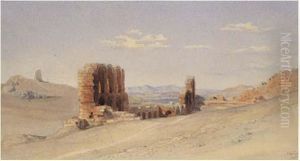Louis Alfred Chaudet Paintings
Louis Alfred Chaudet was a French sculptor born in 1831 in Paris, France. His life spanned much of the 19th century, a period that witnessed significant transformations in the arts, including the transition from Neoclassicism to Romanticism and the beginnings of Modernism. Chaudet, however, remained deeply rooted in the classical tradition, drawing inspiration from ancient Greek and Roman art as well as from the Renaissance. His works are characterized by their detailed precision, harmonious proportions, and a sense of ideal beauty, reflecting the influence of these periods.
Chaudet was educated at the École des Beaux-Arts in Paris, the premier art school in France, where he studied under prominent sculptors of the time. His education and talent soon earned him recognition in the form of awards and commissions. He was a recipient of the prestigious Prix de Rome in sculpture, which afforded him the opportunity to study at the French Academy in Rome, Villa Medici. This experience in Rome was instrumental in shaping his artistic direction, allowing him to study classical sculptures and Renaissance artworks firsthand.
Throughout his career, Chaudet produced a number of notable sculptures, including public monuments, busts, and decorative works that were widely acclaimed in his time. His ability to imbue classical forms with a sense of life and emotion made his work popular among patrons and the public alike. Despite his success, Chaudet's works are less well-known today compared to those of some of his contemporaries. This is perhaps due to the overshadowing impact of the dramatic changes in the art world during the latter part of the 19th century, as Impressionism and then Post-Impressionism began to dominate the artistic landscape.
Louis Alfred Chaudet's contributions to French sculpture are significant, though, reflecting the academic training and classical ideals that were valued highly in his era. He died in 1902 in Paris, leaving behind a legacy that, while perhaps not as widely recognized today, played an important role in the continuation and evolution of classical traditions in French art. His works remain a testament to his skill and dedication to the classical ideals of beauty and proportion.
